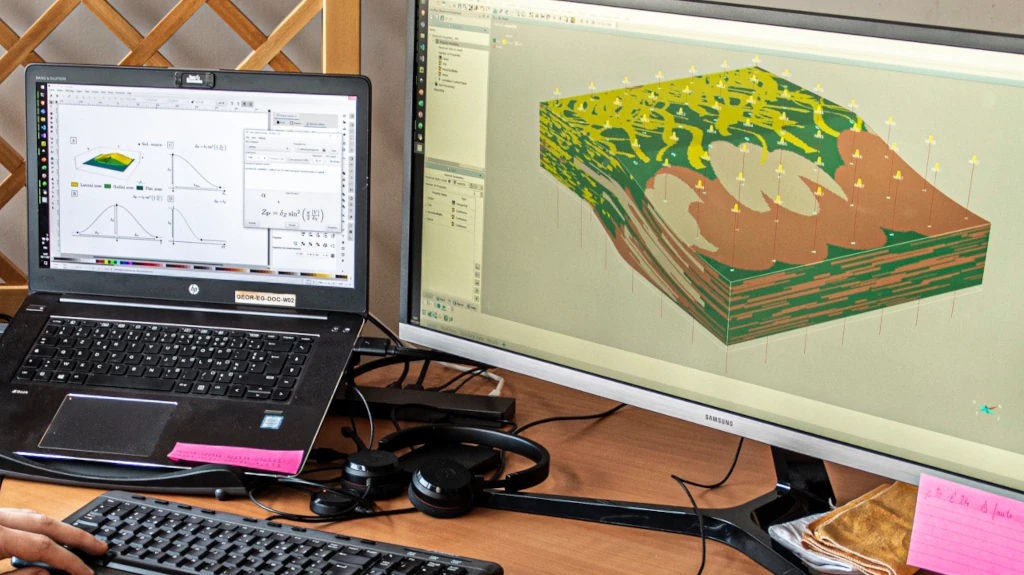
Thesis offer: reverse homogenization for the characterization of fault systems
Before applying for this offer, please contact the following person: Paul Cupillard
Application deadline : 30/06/2025
Starting date : 01/10/2025
Context
The successful candidate will work within the Ring team, a multidisciplinary group made up of 12 to 15 researchers, engineers and doctoral students, working at interface between geosciences, computer science and applied mathematics. The team is part of the National School of Geology, within the GeoRessources laboratory, a research laboratory of the University of Lorraine and the CNRS. The research team is driven by the passion to develop computer methods and theories for geological and geophysical modeling, serving the geoscience community in order to meet the scientific challenges related to natural resource management.
Keywords
- Full Waveform Inversion,
- geomodeling,
- computational seismology,
- estimate ofuncertainties.
detail of theoffer
map faults in the basement and understand their properties (CThat is, their geometry, their dimensions, their behavior as a barrier, their growth) is essential to guide decision-making in applications related to underground resources. todaytoday, the interpretations of the faults in depth come mainly from high-resolution models obtained by D-shape inversionComplete wave (FWI, Full WaveForm Inversion), in addition to migrated images. although the ease and precision of theimaging andseismic interpretation continues to progress, problems such as limited seismic data bandwidth, noise,approximation of the physical model and incomplete data coverage remain major challenges for theDetailed imaging of faults (for example, those whose rejection is lower than the seismic vertical resolution) (Dimmen, Rotevatn & Lecomte, 2023). Underestimating the associated uncertainties can lead to overly optimistic model-based forecasts and increase the financial risk of projects dBasement exploitation.
In recent work, Ruggiero, Cupillard & Caumon (2024) propose a two-scale approach that combines the FWI with a refinement inversion to probabilistically estimate the da fault (for example: length, dip, rejection). This approach, based on previous work (Hedjazian, Capdeville & Bodin, 2021; Santos et al., 2024), is called reverse homogenization. Assuming that the FWI provides a smooth representation of real structures, it aims to find all the finer scale models compatible with the FWI solution. As part of this project, we proposeApply this approach to a fault system, cis to say not to a single flaw, but to several, potentially connected. After having tested the method on a synthetic case in 2D, a real case and/or a 3D extension will be considered.
Candidate profile
- The candidate must hold A master’s degree in quantitative earth sciences, geophysics, physics, geomechanics, applied mathematics or computer science.
- He/she is passionate about science and has strong scientific writing skills.
- experience in computer programming as well asexcellent mastery ofEnglish are required.
- Fluency in French is desirable, but not mandatory.
bibliographical reference
- Dimmen V, Rotevatn A & Lecomte I. (2023). Imaging of small-scale faults in seismic reflection data: insights from seismic modeling of faults in outcrop. Marine and Petroleum Geology 147:105980. https://doi.org/10.1016/j.marpetgeo.2022.105980
- Hejazian N, Capdeville Y & Bodin T. (2021). Multiscale seismic imaging with reverse homogenization. Geophysical International Journal 226(1):676-691. https://doi.org/10.1093/GJI/GGAB121
- Ruggiero G, Cupillard P & Caumon G. (2024). Quantifying Fault-Related Uncertainty with Reverse Homogenization. Proc. 2024 Ring Meeting.
- Santos T, Bodin T, Soulez F, Ricard Y & Capdeville Y. (2024). Refining tomography with generative neural networks trained from Geodynamics. Geophysical International Journal 238(3):1676-1695. https://doi.org/10.1093/GJI/GGAE2
